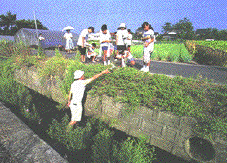 Instruction in a natural setting is an increasingly available option. (Photo: Jiji Gaho sha)
Instruction in a natural setting is an increasingly available option. (Photo: Jiji Gaho sha)A GREENER EDUCATION:
Hokkaido City Kids Go To Rural Schools
FEBRUARY 27, 1997
 Instruction in a natural setting is an increasingly available option. (Photo: Jiji Gaho sha)
Instruction in a natural setting is an increasingly available option. (Photo: Jiji Gaho sha)
Deregulating School Districts
It is 20 years since Hokkaido began to allow children to go to public elementary and middle schools outside their designated school district. Now, an increasing number of inner-city children are getting their schooling on the leafy edge of town in smaller classes amid a natural environment. In the recent climate of unfolding deregulation, there have been more calls for giving students freedom to choose schools. The policy of the northernmost Japanese island has won admirers all over the country, and some schools in Tokyo are expected to make similar reforms this spring.
In Japan, children must attend elementary school for six years and middle school for three. In the case of public schools, the decisions as to which establishments a particular child attends are made on the basis of school districts fixed by a local board of education. Attendance of a school outside the designated area is allowed only if there are geographical, physical, or other restraints that warrant an exception.
This has created an imbalance in Japan's school system. In underpopulated districts, declining rolls have forced schools into closure. At the same time, new residential towns and other areas of rapid population growth have seen their schools grow to enormous proportions, creating a shortage of classrooms and teachers.
Field Study
Halting the decline in school rolls was the initial reason why Hokkaido pioneered relaxation of the catchment-area system at three primary schools in Sapporo. Now, says the Hokkaido capital's board of education, the main consideration is satisfying the wishes of people who favor schooling within a natural environment.
At the elementary school on the outskirts of Sapporo where the new arrangements were first introduced, there was initially only one pupil from a different school district. But the number began to rise in tandem with the growing appeal of the idea of a "natural" education, characterized by ski lessons at neighboring facilities and "forest hour" strolls in the hills and fields in summer. Now about 100 pupils, over half the total, come from other school districts.
Recently, other schools have adopted the system. An elementary school in a dairy-farming area about 30 minutes' drive from downtown Tomakomai, a city in southern Hokkaido, once had over 100 pupils. But as the number of farming families dwindled, the roll shortened until in spring 1995 there were no new pupils. At that point, the decision was taken to relax school-district rules. Now, around half of the 41 children are from the local catchment area, but the remaining 20 come in from outside by bus and other means.
The special boast of this school, which is surrounded by woods, farms, and streams, is small-class instruction in a setting teeming with natural features. In the woods behind the school, there are leisure facilities such as footpaths and birdwatching sites. For each of the pupils, there is 3.3 square meters of vegetable garden, enabling them to experience agriculture at first hand and to grow shiitake mushrooms and the like. The school also has fishing tackle, so that pupils can catch dace and trout in the stream after lessons. It has also won praise because there are only between 5 and 10 children in each grade, making individualized teaching possible.
The word has spread among inner-city parents, and there have been more queries and visitors. This spring, there have already been 12 applications from outside the catchment area regarding the eight available first-grade slots.
Tokyo Takes Note
As part of the rising tide of deregulation, which has become a matter of state policy, the Administrative Reform Committee, an advisory panel to the Prime Minister, in December prepared a report titled "Making the school-district system flexible from the perspective of increasing students' freedom to choose schools." This document prompted educational experts nationwide to look closely at what was happening in Hokkaido. In particular, boards of education all over Tokyo, where many public schools are struggling with a drop in the number of children and competition from the private sector, have reacted positively to the system.
A case in point is Hachioji City, a western suburb of Tokyo. An elementary school district on the mountainous fringe of town is suffering depopulation and the school roster is down to 41. Because further depopulation is predicted, it was decided to throw open the school doors to pupils from all over Hachioji beginning this spring. "It's a very natural environment," says a member of the town's board of education. "With many parents seeking a more rounded-out education with teachers who know pupils as individuals, we ought to be able to respond appropriately." The board seems confident about the first trial.
Schools in city centers, which are suffering from falling residential populations, are also beginning to prepare for more flexible catchment-area rules. Chiyoda Ward includes the well-heeled business districts of Marunouchi and Otemachi. In response to the Administrative Reform Committee's report, an idea that is a variant of the Hokkaido approach has surfaced. Proposed is a switch to a system in which all eight elementary and middle schools in the ward would be equipped to offer specialized education in, say, personal computing or traditional arts, and children would be able to attend any one of them without regard to the catchment areas.
The Ministry of Education is preparing to inform regional boards of education all over the country of the experience of Hokkaido and Tokyo. Further rapid progress is expected in loosening up the school-district system, and giving parents rights of choice of school.